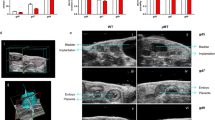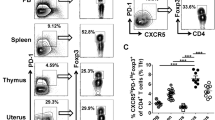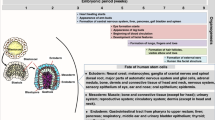Abstract
Pregnancy is an intricately orchestrated process where immune effector cells with fetal specificity are selectively silenced. This requires the sustained expansion of immune-suppressive maternal FOXP3+ regulatory T cells (Treg cells), because even transient partial ablation triggers fetal-specific effector T-cell activation and pregnancy loss1,2. In turn, many idiopathic pregnancy complications proposed to originate from disrupted fetal tolerance are associated with blunted maternal Treg expansion3,4,5. Importantly, however, the antigen specificity and cellular origin of maternal Treg cells that accumulate during gestation remain incompletely defined. Here we show that pregnancy selectively stimulates the accumulation of maternal FOXP3+ CD4 cells with fetal specificity using tetramer-based enrichment that allows the identification of rare endogenous T cells6. Interestingly, after delivery, fetal-specific Treg cells persist at elevated levels, maintain tolerance to pre-existing fetal antigen, and rapidly re-accumulate during subsequent pregnancy. The accelerated expansion of Treg cells during secondary pregnancy was driven almost exclusively by proliferation of fetal-specific FOXP3+ cells retained from prior pregnancy, whereas induced FOXP3 expression and proliferation of pre-existing FOXP3+ cells each contribute to Treg expansion during primary pregnancy. Furthermore, fetal resorption in secondary compared with primary pregnancy becomes more resilient to partial maternal FOXP3+ cell ablation. Thus, pregnancy imprints FOXP3+ CD4 cells that sustain protective regulatory memory to fetal antigen. We anticipate that these findings will spark further investigation on maternal regulatory T-cell specificity that unlocks new strategies for improving pregnancy outcomes and novel approaches for therapeutically exploiting Treg cell memory.
This is a preview of subscription content, access via your institution
Access options
Subscribe to this journal
Receive 51 print issues and online access
$199.00 per year
only $3.90 per issue
Buy this article
- Purchase on Springer Link
- Instant access to full article PDF
Prices may be subject to local taxes which are calculated during checkout




Similar content being viewed by others
References
Kahn, D. A. & Baltimore, D. Pregnancy induces a fetal antigen-specific maternal T regulatory cell response that contributes to tolerance. Proc. Natl Acad. Sci. USA 107, 9299–9304 (2010)
Rowe, J. H., Ertelt, J. M., Aguilera, M. N., Farrar, M. A. & Way, S. S. Foxp3+ regulatory T cell expansion required for sustaining pregnancy compromises host defense against prenatal bacterial pathogens. Cell Host Microbe 10, 54–64 (2011)
Prins, J. R. et al. Preeclampsia is associated with lower percentages of regulatory T cells in maternal blood. Hypertens. Pregnancy 28, 300–311 (2009)
Santner-Nanan, B. et al. Systemic increase in the ratio between Foxp3+ and IL-17-producing CD4+ T cells in healthy pregnancy but not in preeclampsia. J. Immunol. 183, 7023–7030 (2009)
Sasaki, Y. et al. Decidual and peripheral blood CD4+CD25+ regulatory T cells in early pregnancy subjects and spontaneous abortion cases. Mol. Hum. Reprod. 10, 347–353 (2004)
Moon, J. J. et al. Naive CD4+ T cell frequency varies for different epitopes and predicts repertoire diversity and response magnitude. Immunity 27, 203–213 (2007)
Aluvihare, V. R., Kallikourdis, M. & Betz, A. G. Regulatory T cells mediate maternal tolerance to the fetus. Nature Immunol. 5, 266–271 (2004)
Andersen, K. G., Nissen, J. K. & Betz, A. G. Comparative genomics reveals key gain-of-function events in Foxp3 during regulatory T cell evolution. Front. Immunol. 3, 113 (2012)
Lathrop, S. K. et al. Peripheral education of the immune system by colonic commensal microbiota. Nature 478, 250–254 (2011)
Shafiani, S., Tucker-Heard, G., Kariyone, A., Takatsu, K. & Urdahl, K. B. Pathogen-specific regulatory T cells delay the arrival of effector T cells in the lung during early tuberculosis. J. Exp. Med. 207, 1409–1420 (2010)
Josefowicz, S. Z., Lu, L. F. & Rudensky, A. Y. Regulatory T cells: mechanisms of differentiation and function. Annu. Rev. Immunol. 30, 531–564 (2012)
Wing, K. & Sakaguchi, S. Regulatory T cells exert checks and balances on self tolerance and autoimmunity. Nature Immunol. 11, 7–13 (2010)
Hsieh, C. S., Lee, H. M. & Lio, C. W. Selection of regulatory T cells in the thymus. Nat. Rev. Immunol. 12, 157–167 (2012)
Suffia, I. J., Reckling, S. K., Piccirillo, C. A., Goldszmid, R. S. & Belkaid, Y. Infected site-restricted Foxp3+ natural regulatory T cells are specific for microbial antigens. J. Exp. Med. 203, 777–788 (2006)
Rosenblum, M. D. et al. Response to self antigen imprints regulatory memory in tissues. Nature 480, 538–542 (2011)
Moon, J. J. et al. Quantitative impact of thymic selection on Foxp3+ and Foxp3− subsets of self-peptide/MHC class II-specific CD4+ T cells. Proc. Natl Acad. Sci. USA 108, 14602–14607 (2011)
Robertson, S. A. Immune regulation of conception and embryo implantation-all about quality control? J. Reprod. Immunol. 85, 51–57 (2010)
Kallikourdis, M., Andersen, K. G., Welch, K. A. & Betz, A. G. Alloantigen-enhanced accumulation of CCR5+ ‘effector’ regulatory T cells in the gravid uterus. Proc. Natl Acad. Sci. USA 104, 594–599 (2007)
Munoz-Suano, A., Hamilton, A. B. & Betz, A. G. Gimme shelter: the immune system during pregnancy. Immunol. Rev. 241, 20–38 (2011)
Thornton, A. M. et al. Expression of Helios, an Ikaros transcription factor family member, differentiates thymic-derived from peripherally induced Foxp3+ T regulatory cells. J. Immunol. 184, 3433–3441 (2010)
Gottschalk, R. A., Corse, E. & Allison, J. P. Expression of Helios in peripherally induced Foxp3+ regulatory T cells. J. Immunol. 188, 976–980 (2012)
Kim, J. M., Rasmussen, J. P. & Rudensky, A. Y. Regulatory T cells prevent catastrophic autoimmunity throughout the lifespan of mice. Nature Immunol. 8, 191–197 (2007)
Erlebacher, A., Vencato, D., Price, K. A., Zhang, D. & Glimcher, L. H. Constraints in antigen presentation severely restrict T cell recognition of the allogeneic fetus. J. Clin. Invest. 117, 1399–1411 (2007)
Ertelt, J. M. et al. Selective priming and expansion of antigen-specific Foxp3− CD4+ T cells during Listeria monocytogenes infection. J. Immunol. 182, 3032–3038 (2009)
Pepper, M. et al. Different routes of bacterial infection induce long-lived TH1 memory cells and short-lived TH17 cells. Nature Immunol. 11, 83–89 (2010)
Koch, M. A. et al. The transcription factor T-bet controls regulatory T cell homeostasis and function during type 1 inflammation. Nature Immunol. 10, 595–602 (2009)
Wakim, L. M. & Bevan, M. J. From the thymus to longevity in the periphery. Curr. Opin. Immunol. 22, 274–278 (2010)
Trupin, L. S., Simon, L. P. & Eskenazi, B. Change in paternity: a risk factor for preeclampsia in multiparas. Epidemiology 7, 240–244 (1996)
Conde-Agudelo, A. & Belizan, J. M. Maternal morbidity and mortality associated with interpregnancy interval: cross sectional study. BMJ 321, 1255–1259 (2000)
Moon, J. J. et al. Tracking epitope-specific T cells. Nature Protocols 4, 565–581 (2009)
Wirth, R., An, F. Y. & Clewell, D. B. Highly efficient protoplast transformation system for Streptococcus faecalis and a new Escherichia coli-S. faecalis shuttle vector. J. Bacteriol. 165, 831–836 (1986)
Smith, K. & Youngman, P. Use of a new integrational vector to investigate compartment-specific expression of the Bacillus subtilis spoIIM gene. Biochimie 74, 705–711 (1992)
Foulds, K. E. et al. Cutting edge: CD4 and CD8 T cells are intrinsically different in their proliferative responses. J. Immunol. 168, 1528–1532 (2002)
Rudd, B. D. et al. Nonrandom attrition of the naive CD8+ T-cell pool with aging governed by T-cell receptor:pMHC interactions. Proc. Natl Acad. Sci. USA 108, 13694–13699 (2011)
Acknowledgements
We thank M. Jenkins for providing 2W1S-expressing mice, and A. Rudensky for providing Foxp3DTR mice. This research was supported by NIH-NIAID awards R01AI087830 and R01AI100934 (S.S.W.), and NIH-NIDDK award F30DK084674 (J.H.R.). S.S.W. holds an Investigator in the Pathogenesis of Infectious Disease award from the Burroughs Wellcome Fund.
Author information
Authors and Affiliations
Contributions
J.H.R., J.M.E., L.X. and S.S.W. designed and performed the experiments, and wrote the paper.
Corresponding author
Ethics declarations
Competing interests
The authors declare no competing financial interests.
Supplementary information
Supplementary Figures
This file contains Supplementary Figures 1-10. (PDF 2223 kb)
Rights and permissions
About this article
Cite this article
Rowe, J., Ertelt, J., Xin, L. et al. Pregnancy imprints regulatory memory that sustains anergy to fetal antigen. Nature 490, 102–106 (2012). https://doi.org/10.1038/nature11462
Received:
Accepted:
Published:
Issue Date:
DOI: https://doi.org/10.1038/nature11462
This article is cited by
-
Abrupt perturbation and delayed recovery of the vaginal ecosystem following childbirth
Nature Communications (2023)
-
CD4+ T cell memory
Nature Immunology (2023)
-
Umbilical Cord Maternal Microchimerism in Normal and Preeclampsia Pregnancies
Reproductive Sciences (2023)
-
Pregnancy-specific responses to COVID-19 revealed by high-throughput proteomics of human plasma
Communications Medicine (2023)
-
Histone methyltransferase Nsd2 ensures maternal–fetal immune tolerance by promoting regulatory T-cell recruitment
Cellular & Molecular Immunology (2022)
Comments
By submitting a comment you agree to abide by our Terms and Community Guidelines. If you find something abusive or that does not comply with our terms or guidelines please flag it as inappropriate.



